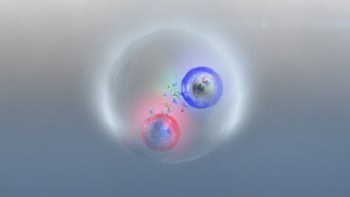
The enigmatic Ξ(2030) particle, once thought to consist of three quarks, may actually be a molecular pentaquark – an exotic hadron comprising five quarks. That is the conclusion of Chinese physicists Cai Cheng and Jing-wen Feng at Sichuan Normal University and Yin Huang at Southwest Jiaotong University. They employed a simplified strong interaction theory to calculate the decay rate of the exotic hadron, concluding that it comprises five quarks.
This composition aligns more closely with experimental data than does the traditional three-quark model for Ξ(2030). While other pentaquarks have been identified in accelerator experiments to date, these particles are still considered exotic and are poorly understood compared to two-quark mesons and three-quark baryons. As a result, this latest work is a significant step towards understanding pentaquarks.
The Ξ(2030) is named for its mass in megaelectronvolts and was first discovered at Fermilab in 1977. At that time, the idea of exotic hadrons that did not fit into the conventional meson–baryon classification was not widely accepted. Conventionally, a meson comprises a quark and an antiquark and a baryon contains three quarks.
Deviation from three-quark model
Consequently, based on its properties, the scientific community classified the particle as a baryon, similar to protons and neutrons. However, further investigations at CERN, SLAC, and Fermilab revealed that the particle’s interaction properties deviated significantly from what the three-quark model predicted, leading scientists to question its three-quark nature.
To address this issue earlier this year, Yin Huang and colleague Hao Hei proposed that the Ξ(2030) could be a molecular pentaquark, suggesting that it consists of a meson and a baryon loosely bound together by the strong nuclear force. In the present study, Cheng, Feng, and Huang elaborated on this idea, analysing a model where the particle is composed of a K meson, which contains a strange antiquark and a light quark (either up or down), alongside a Σ baryon that comprises a strange quark and two light quarks.
To do the study, the team had to use a simplified approach to calculating strong interactions. This is because quantum chromodynamics, the comprehensive theory describing such interactions, is too complex for detailed calculations of hadronic properties. Their approach focuses on hadrons rather than the fundamental quarks and gluons that make up hadrons. They calculated the probabilities of the Ξ(2030) decaying into various strongly interacting particles, including π and K mesons, as well as Σ and Λ baryons.
“It is confirmed that this particle is a hadron molecular state, and its core is primarily composed of K and Σ components,” explains Feng. “The main decay channels are K+Σ and K+Λ, which are consistent with the experimental results. This conclusion not only deepens our understanding of the internal structure of the Ξ(2030), but also further supports the applicability of the concept of hadronic molecular state in particle physics.”
Extremely short lifetime
The Ξ(2030) particle has an extremely short lifetime of about 10-23 s , making it challenging to study experimentally. As a result, measuring its properties can be imprecise. The uncertainty surrounding these measurements means that comparisons with theoretical results are not always conclusive, indicating that further experimental work is essential to validate the team’s claims regarding the interaction between the meson and baryons that make up the Ξ(2030).
“However, experimental verification still needs time, involving multi-party cooperation and detailed planning, and may also require technological innovation or experimental equipment improvement,” said Huang.
Despite the challenges, the researchers are not pausing their theoretical investigations. They plan to delve deeper into the structure of the Ξ(2030) because the particle’s complex nature could provide valuable insights into the subatomic strong interaction, which remains poorly understood due to the intricacies of quantum chromodynamics.
“Current studies have shown that although the theoretically calculated total decay rate of Ξ(2030) is basically consistent with the experimental data, the slight difference reveals the complexity of the particle’s internal structure,” concluded Feng. “This important discovery not only reinforces the hypothesis of Ξ(2030) as a meson–baryon molecular state, but also suggests that the particle may contain additional components, such as a possible triquark configuration.”
Moreover, the very conclusion regarding the molecular pentaquark structure of Ξ(2030) warrants further scrutiny. The effective theory employed by the authors draws on data from other experiments with strongly interacting particles and includes a fitting parameter not derived from the foundational principles of quantum chromodynamics. This raises the possibility of alternative structures for Ξ(2030).
“Maybe Ξ(2030) is a molecular state, but that means explaining why K and Σ should stick together – [Cheng and colleagues] do provide an explanation but their mechanism is not validated against other observations so it is impossible to evaluate its plausibility,” said Eric Swanson at University of Pittsburgh, who was not involved in the study.
The research is described in Physical Review D.



